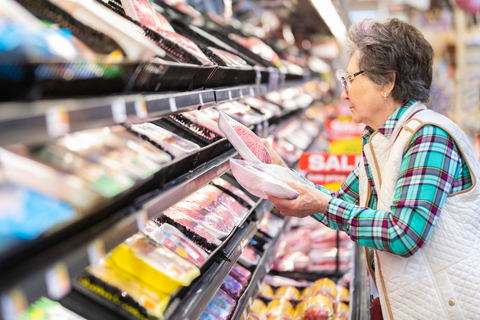Jane Merschman, Executive Board member of Clearwater County Food Shelf in Bagley, Minnesota saw a big jump in food shelf use in February and again at the beginning of March. Members of her rural community often drive 30 miles one way to work in Bemidji making the increase in gas prices is one factor driving food shelf usage. “Wages aren’t going up, so you have to find food some other place.” She referenced letters from Hunger Solutions as well as her regional food bank indicating that some foods are not as available as they have been in the past due to the reduction in COVID-related funding. Bob Hansen, director of the Park Rapids Food Shelf has noticed the difference. “Staple items, like 18 oz canisters of oatmeal, aren’t available. Same with rice – I need to go to the local grocery store for this, and sometimes they don’t have it either.”
The USDA Economic Research Service recently reported that the price of groceries (“food-at-home”) has risen over 1% in the past month, and more than 7% over the past year. They anticipate that grocery prices will increase by 2-3% more in 2022. Some food prices are rising more rapidly than others, for example, fish and seafood prices are expected to increase 4% in 2022.
These and other concerns about food prices are part of the normal chatter these days in University of Minnesota Extension health and nutrition classes. The pace and degree with which food prices have increased in the past year have required families to make big adjustments in a short amount of time. Food prices, along with increases in gas prices and the many challenges related to the COVID-19 pandemic, have posed a real threat to nutrition security among low-income families.
University of Minnesota Extension offers resources to help individuals and families manage their budgets and keep healthy food in their cupboards. For those that participate in health and nutrition programs across the state, the educators provide tools and tips for stretching their food dollars. They regularly teach and guide families with limited financial resources on ways to access affordable, healthy foods, and share programs and resources to help them keep their cupboards full.
The Real Life, Good Food website has tips to help you grocery shop for healthy foods while staying within your budget. It also has a map of food shelves across the state, information about food benefit programs to increase your access to healthy foods, and contact information for the Minnesota Food Helpline for households needing food.
Free webinars to help families save money
Extension also offers Thrifty Thursday and other budgeting webinars to help families develop money management skills during difficult economic times:
- March 31 - Thrifty Thursdays - Building Credit with a Credit Card
- April 7 - Thrifty Thursdays - Budgeting with a Calendar System
- April 12 - Make Money Make Sense
- April 14 - Thrifty Thursdays - Budgeting Using Apps or Excel
- April 19 - Get Ready, Get Set, Get Going: A Guide to Money Management
- April 21 - Thrifty Thursdays - Budgeting with an Envelope System
- April 28 - Thrifty Thursdays - Plugging Your Spending Leaks
Learn more and register for one or all upcoming events.
Permission is granted to news media to republish our news articles with credit to University of Minnesota Extension. Images also may be republished; please check for specific photographer credits or limited use restrictions in the photo title.


